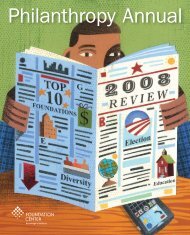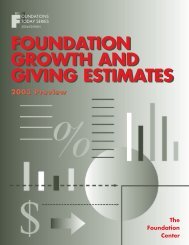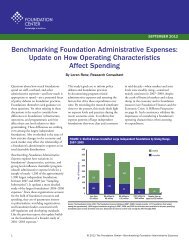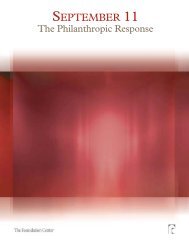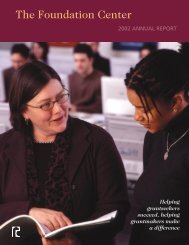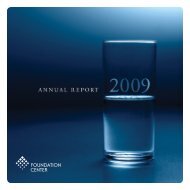Download Philanthropy Annual PDF - Foundation Center
Download Philanthropy Annual PDF - Foundation Center
Download Philanthropy Annual PDF - Foundation Center
You also want an ePaper? Increase the reach of your titles
YUMPU automatically turns print PDFs into web optimized ePapers that Google loves.
to community may be the most<br />
important source of societal resilience,<br />
and that therefore the loss of<br />
social capital may be a fundamental<br />
one that can erode all else. If that is<br />
so, rebuilding social capital should<br />
be our priority. And that is where<br />
the nonprofit sector and the philanthropic<br />
sector have critical roles to<br />
play. And, of course, political leadership<br />
is key.<br />
PND: What are the implications of<br />
the global financial meltdown for<br />
international philanthropy?<br />
Should we expect to see<br />
reductions in philanthropic<br />
capital flows from the<br />
developed world to developing<br />
countries over the next<br />
couple of years?<br />
JW: You’re already seeing<br />
an enormous reduction<br />
in remittances, which is a<br />
significant source of income for<br />
many countries. And as foundation<br />
endowments shrink, so will their<br />
giving. But the impact of that will<br />
be more gradual than the immediate<br />
impact of frozen or declining<br />
capital markets. That is because<br />
foundations tend to calculate the<br />
amount they give each year based<br />
on a rolling average of asset values<br />
over a three- to five-year period. The<br />
idea is to ensure that when asset<br />
values decline, as they do from time<br />
to time, giving declines gradually<br />
rather than precipitously. At the<br />
same time, in September, when it<br />
became apparent that the economy<br />
was facing a deep and significant<br />
recession, a number of foundations<br />
became more forward-leaning and<br />
decided to increase their payout<br />
— rather than pay out 5 percent<br />
of their assets, as required, they<br />
decided to increase that percentage.<br />
That said, as the recession<br />
has deepened, many foundations<br />
have begun to worry more about<br />
protecting the corpus and conserving<br />
their endowments for the future. So<br />
I think we will see a decline, albeit a<br />
relatively gradual decline, in philanthropic<br />
giving, and I would expect to<br />
see giving rebound, albeit gradually,<br />
as the economy rebounds.<br />
PND: The Global <strong>Philanthropy</strong> Forum<br />
will hold its eighth annual conference<br />
in Washington, DC, later this month.<br />
The conference will focus on five<br />
interlocking crises: poverty, at home<br />
and abroad; climate change; access<br />
to health care; education; and averting<br />
state failure in the wake of conflicts.<br />
That’s an ambitious agenda.<br />
Why has the forum decided to consider<br />
those five issues together, and<br />
what are the benefits of doing so?<br />
JW: We’ve selected those issues<br />
because they are in the in-box of<br />
not only the president of the United<br />
States, but of leaders worldwide.<br />
And in each instance, governments<br />
cannot solve these problems alone.<br />
Indeed, the public sector will need<br />
to be able to tap all sources of<br />
social innovation — be they from the<br />
private, philanthropic, or civic sector.<br />
They will need the agility and inventiveness<br />
of each. You noted that the<br />
five issues are interlocking, and that<br />
is correct. You cannot solve the problem<br />
of poverty, for example, without<br />
addressing the need for access to<br />
affordable health care for all and<br />
without creating a level playing field<br />
when it comes to providing quality<br />
education. Each of these problems<br />
is in essence a symptom of a<br />
syndrome that causes societies to<br />
crumble and states to fail. So they<br />
need to be looked at as a whole,<br />
and that’s what we’ve chosen to do.<br />
PND: Increasingly, foundations,<br />
corporations, and high-net-worth<br />
individuals are applying a strategic<br />
lens to their philanthropy. According<br />
to one currently popular view, being<br />
strategic in a philanthropic context<br />
...rebuilding social capital should be our<br />
priority. And that is where the nonprofit<br />
sector and the philanthropic sector have<br />
critical roles to play....<br />
means having clarity about your<br />
goals, having a strategy based on<br />
sound evidence for achieving those<br />
goals, building in feedback loops<br />
that enable you to course-correct<br />
as you work toward your goals, and<br />
periodically evaluating the impact of<br />
your efforts. Is that a viable framework<br />
for philanthropic interventions<br />
in developing countries?<br />
JW: It is. In fact, as someone who<br />
worked at Carnegie Corporation, the<br />
Rockefeller Brothers Fund, and the<br />
W. Alton Jones <strong>Foundation</strong>, I would<br />
say that that has been the approach<br />
of most private foundations that<br />
have worked internationally. But<br />
what foundations must keep in<br />
mind is that the process of evaluation<br />
can be very expensive for the<br />
grantee to bear. This means funders<br />
need to, at a minimum, share the<br />
burden of evaluation, if not underwrite<br />
that expense altogether. At<br />
Carnegie Corporation, for example,<br />
People Who Make a Difference | 39



